Requiem
for a Planet: Pluto
|
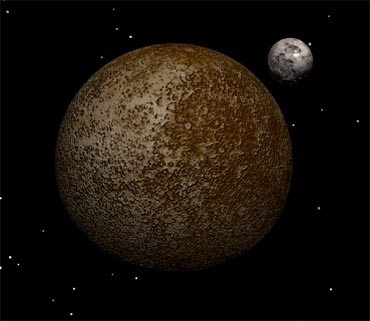
Artist
conception of Pluto and its moon Charon. (Copyright
Lee Krystek, 2012)
|
For almost three-quarters of a century schoolchildren
learned that our solar system had 9 planets: Mercury, Venus,
Earth, Mars, Jupiter, Saturn, Uranus, Neptune and Pluto. Then
in 2006 this changed, Pluto got demoted and now there are only
eight planets. What happened? Why did poor Pluto get kicked
out of the planetary club?
Wandering
Stars
To understand why Pluto isn't a planet, perhaps
it helps if we define what the term planet means. The
expression goes back to ancient times and comes from the Greek
word for "wandering star." Because the planets are bodies that
move in orbit around the sun, they do not stay in a fixed location
in the sky in relation to the stars. Ancient peoples, including
the Greeks, noticed that over a course of months these special
stars seemed to move along a particular path across the sky.
Usually it was in one direction, but occasionally they would
move backwards, then again forwards. The constellations (or
star groups) that they passed through were given special significance,
and today we know these as the zodiac.
It was clear to these early observers that the
wandering stars were different from the stationary ones, but
they didn't know exactly why. Back then the Greeks didn't have
telescopes and they were limited to using their naked eyes.
This meant they were only familiar with the most brilliant of
these wanders which they named for their gods. Today we are
aquainted with the Roman versions of these names: The brightest
was Jupiter, king of the gods, Saturn was his father, Venus
was the goddess of love, Mars, which appeared to be an angry
red, was the god of war, and Mercury was the messenger god.
|
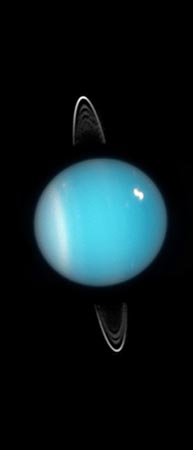
Uranus
was the first planet discovered in modern times, though
Herschel's telescope wasn't powerful enough for him to
see that it had rings. (NASA)
|
So in ancient times there were only six planets.
They weren't the only things that moved through the night sky,
however. Comets also progressed against the background of the
stars. Comets only appeared at very irregular intervals, though,
and they often had a long tail (comet actually means "hairy
star") so they were put into a different category than the planets.
New
Planets
Additional planets were not discovered until telescopes were
invented and the mechanics of how the solar system was arranged
- with the Earth orbiting around the sun, and not the reverse
- was understood. By the end of the 16th century Uranus had
been observed and recorded several times, but people who saw
it just thought it was a regular star or comet. In March of
1781 Sir William Herschel found it again and began to track
its motion. His first thought was that it was a comet, but
he and his fellow astronomers calculated that its orbit was
nearly circular around the sun and realized it was a planet
beyond Saturn. Herschel wanted to name it after the British
King, George III, but foreign astronomers disagreed and eventually
the name Uranus, god of the sky, was approved by consensus.
Surprisingly, Pluto was not the first member to be kicked
out of the planetary club. As far back as 1596, Johannes Kepler
had come to the conclusion that there was a gap between Mars
and Saturn large enough to accommodate another planet. The
discovery of Uranus further confirmed that there was a pattern
to how far planets were apart and that there was indeed an
empty space. In 1800 a number of astronomers started on an
intense search for such a planet in the gap. On January 1st,
1801, Italian scientist Giuseppe Piazzi found a small object
that was in a circular orbit in the right location. It was
declared a planet and named Ceres after the Roman god
of agriculture.
It soon became apparent, however, that Ceres,
with a diameter of 569 miles (960km), was much smaller than
the other planets. Within a year astronomers also realized it
was not alone. A large number of similar, but smaller, objects
were found orbiting in that region of space. Sir William Herschel
coined the term asteroids (which means "star-like") for such
bodies. Though there was no official organization at the time
to change the status of Ceres, within a few decades all references
to it being a planet disappeared from the textbooks. Today we
refer to the area in which Ceres and the other asteroids are
found as the "asteroid belt."
|
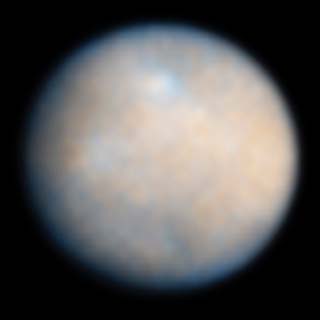
Ceres:
Got kicked out of the club too (NASA).
|
In 1846 the French scientist Urbain Le Verrier,
looking at the orbit of Uranus, came to the conclusion that
the way it moved suggested it was being pulled by the gravity
of an unknown body, probably another planet beyond Uranus's
orbit. He calculated where this planet could be found in the
sky and asked German astronomer Johann Gottfried Galle to search
for it with his telescope. Galle found it and it was dubbed
Neptune after the Roman god of the sea. In England John
Couch Adams had independently made the same calculations, but
couldn't find anybody with a telescope who would take him seriously
enough to do a search.
The
Search for the Ninth Planet
By the start of the 20th century scientists had
noticed the same type of unexplained motions in Neptune's orbit
that when seen in Uranus's orbit had led to Neptune's discovery.
Many astronomers began to suspect that there might be a 9th
planet out there somewhere. In 1906 Percival Lowell, a wealthy
Bostonian who had founded the Lowell Observatory, started a
search for it. When it still hadn't been found by his death
in 1916, the observatory hired an eager, 23-year-old astronomer
named Clyde Tombaugh to continue the search in 1929.
Tombaugh went at the tedious task tirelessly.
Each night he would photograph a section of the sky where the
planet was suspected to be. He then used a device called a blink
comparator, which allowed him to quickly switch back and forth
between pictures, to contrast that photo with one taken a few
weeks before. If any of the stars seemed to jump between the
two photos, he would know it was moving. This meant it was either
a comet or a planet.
|
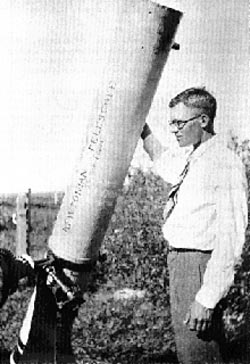
A
young Clyde Tombaugh found Pluto (NASA)
|
On February 18, 1930, Tombaugh was looking at
a pair of photographs taken the month before when he saw such
a jump. Additional observations confirmed that the object appeared
to be in a near circular orbit around the sun and it seemed
that the 9th planet had finally been found.
The discovery was a world-wide sensation. Tombaugh
urged that a name be quickly selected. Some of the suggestions
included Zeus (the Greek name for the king of the gods) and
Percival, after the Lowell founder. Strangely enough, the name
Pluto came from an 11-year-old schoolgirl named Venetia
Burney who lived in Oxford, England. She had been studying the
Greek classics and thought that the name of the god of the underworld
would be perfect for such a cold and lifeless orb at the edge
of the solar system. Her grandfather, a retired Oxford librarian,
passed the idea onto a professor, who cabled the idea to the
Lowell. The name received a unanimous vote by the Lowell staff
and was announced on May 1, 1930. Its selection may have been
influenced by the first two letters being "PL" which were also
the initials of Percival Lowell.
The
Odd Planet
It wasn't long after Pluto's addition to the planetary
club that people began to notice that "one of these things was
not like the others." The first problem was its orbit. Further
careful studies showed that it wasn't as circular as had been
supposed. In fact, the orbit was so elliptical (like a squashed
circle) that it actually was closer than Neptune to the sun
for part of its year. Also, while the rest of the planets orbited
along a flat plane called the ecliptic, Pluto's orbit was tilted
off that plane by over 17°.
There was also the question of its size. Early
estimates made shortly after Pluto was found suggested it was
about the same diameter as Earth. However, as telescopes got
better and better it appeared that Pluto was smaller and smaller.
In 1978 astronomer James Christy found that Pluto had a moon
(later named Charon after a minion of the god Pluto in mythology)
and observation of its orbit allowed scientists to get a very
accurate measurement of Pluto's size: only 0.2% of the mass
of Earth.
|
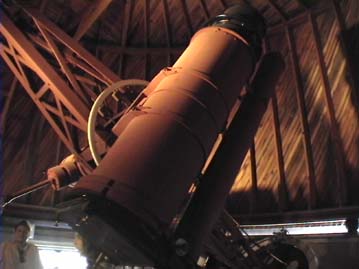
The
telescope Tombaugh used in his search for Pluto. (Copyright
Lee Krystek, 2012)
|
Other discoveries appeared that caused some astronomers
to question Pluto's status. In 1992 scientists found evidence
that there was a large disc of scattered rocky and icy material
out beyond the orbit of Neptune. They dubbed this the "Kuiper
Belt" in honor of Gerard Kuiper who had speculated about such
a region back in the 1950's. Some scientists began to suggest
that rather than being a planet, Pluto was just the largest
member of this belt.
Planet
Eris
The matter came to a head in 2005 when astronomer
Mike Brown, working at the Palomar Observatory, discovered an
object far out beyond Neptune. It was eventually named Eris
(after the Greek goddess of strife - an apt name given all the
controversy it would cause). What was alarming about Eris was
that it appeared, with a diameter of 2,397km (1400 miles), that
it was just slightly bigger than Pluto. Should it be the tenth
planet?
The International Astronomical Union (IAU), which
was the group that had taken over the official naming of celestial
objects, was forced to confront the question the next year.
The IAU had three ways they could resolve the problem. Each
solution required them to develop an official definition of
the term planet, something that had never actually been done
before.
First, they could simply define a planet as an
object bigger than Pluto that orbited the sun in a roughly circular
orbit. This would make Eris the tenth planet. The downside of
this was that there were indications that Eris was not out there
alone. This meant that the ranks of the planets might rapidly
swell with these small, far-away objects.
|
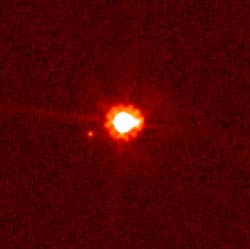
Eris
as seen by the Hubble Telescope. (NASA)
|
The second thing they could do was to declare
objects like Eris and Pluto to be something other than planets.
This new class would include anything like them that was found
after this point in time.
There was a third possibility which was to keep
Pluto in the planetary club for historical reasons and place
Eris and other newly-found objects into a new class. Supporters
of this approach cited our commonly-held belief that the earth,
for reasons of history, has seven continents, even though it
is clear that under any logical definition Europe and Asia are
a single landmass.
The IAU decided on the second approach and defined
a planet as a body going around the sun, large enough to take
on a spherical shape and "clear the neighborhood around its
orbit" of other objects. Since Pluto shared its space with other
Kuiper Belt bodies, it failed this last test. A new class of
objects called dwarf planets was created and Pluto and Eris
were placed into this category.
Controversy
Not everybody was happy with the IAU's decision.
Astronomer Alan Stern, leader of NASA's New Horizon's mission
to Pluto, complained that the new definition was too vague and
inaccurate as many of the traditional planets have asteroid-type
objects orbiting near them so they have not "cleared their neighborhoods."
He also noted that only about 5% of professional astronomers
had been available to vote on the issue. However, Mike Brown,
who might have been credited with the discovery of a new planet
if the decision had gone another way, said that he thought that
the IAU had done the right thing. "There will be hundreds of
dwarf planets," Brown predicted.
The decision was probably made easier by Tombaugh's
death in 1997. Few members of the IAU would have wanted to strip
the eminent astronomer of his greatest success. His widow remarked,
however, that he would have accepted the change. She said Clyde
"was a scientist. He would understand they had a real problem
when they started finding several of these things flying around
the place."
|
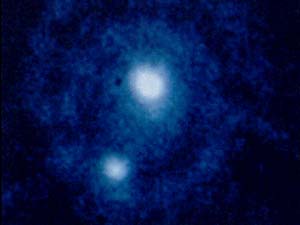
A
picture of Pluto and Charon taken by the Hubble Telescope
(NASA)
|
As least a few political entities have come to
Pluto's defense because of their connection with Tombaugh. In
Illinois, where the astronomer was born, the state senate passed
a resolution saying that Pluto was "unfairly downgraded to a
'dwarf' planet." Similarly in New Mexico, where Tombaugh had
been a long-time resident, the House of Representatives passed
a resolution declaring that "Pluto will always be considered
a planet while in New Mexican skies."
For those that are sad about Pluto's fate, perhaps
it is best not to think of the planet getting as demotion, but
of having the honor of being a founding member of a whole new
class. The dwarf planets of our solar system now include Pluto
and Eris along with Haumea, Makemake, Sedna and Quaoar.
Even Ceres, which got kicked out of the planetary club
back in the 19th century, has been able to join this new group
(though it also retains its membership in the asteroid belt).
Will the definition of a planet change again?
Perhaps. Astronomers have spent the last 20 years searching
for planets circling stars other than the sun. As they find
more it's likely that we will find objects that don't quite
meet the current definition. Some change seems inevitable.
Is there still a 9th planet out there in our solar
system that might fit the IAU's new definition? In 1992 when
the Voyager 2 space probe flew by Neptune it got a chance to
get a better gauge on the planet's mass. This new information
showed that it was slightly smaller than originally thought.
When the planet's new size was used to recalculate its orbit,
the movements that suggested that there was a 9th planet tugging
on Neptune vanished. So it seems likely that the eight local
planets we are familar with are the only ones we have.
|
Meep
reacts to rumors that Pluto will be demoted in our comic
strip LGM.
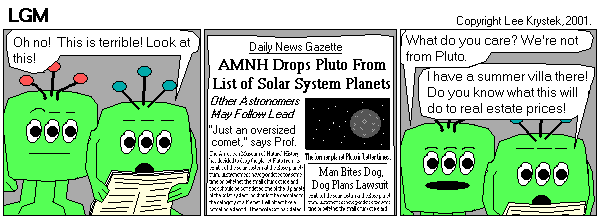
|
A Partial Bibliography
Pluto Demoted: No Longer
a Planet in Highly Controversial Definition, by Robert Roy
Britt, Space.com, http://www.space.com/2791-pluto-demoted-longer-planet-highly-controversial-definition.html
The girl who named a planet
by Paul Rincon, BBC News, http://news.bbc.co.uk/2/hi/science/nature/4596246.stm
Planet Quest: The Epic Discovery
of Alien Solar Systems, by Ken Croswell, The Free Press,
1997.
Discovering Pluto, Lowell
Observatory, http://www.lowell.edu/about_history_pluto.php

Copyright
2012 Lee Krystek. All Rights Reserved.